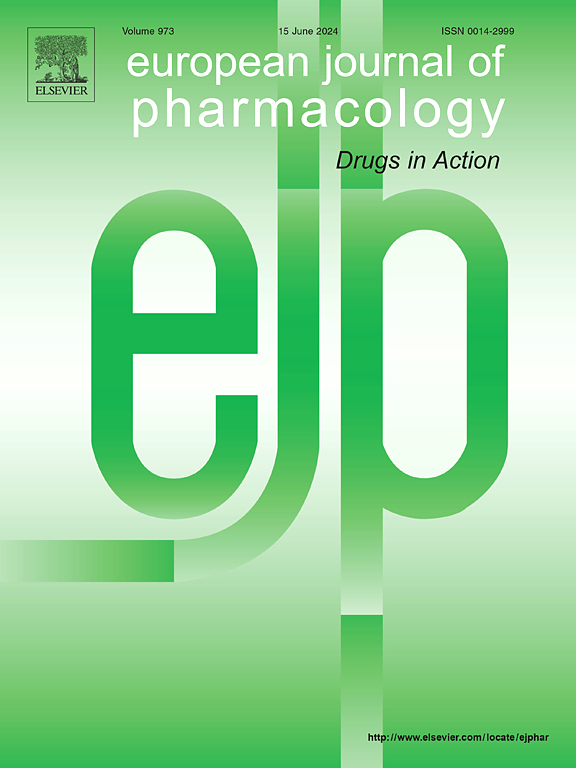Anti-inflammatory and anti-oxidant potential of dispiro-indanedione hybrid of parthenin via regulating Nrf2 and NF-κB/MAPK pathways
IF 4.2
3区 医学
Q1 PHARMACOLOGY & PHARMACY
引用次数: 0
Abstract
Steroidal and non-steroidal anti-inflammatory drugs are widely used for treating a spectrum of inflammatory conditions; however, their systemic adverse effects hinder their usage. Therefore, alternate therapeutic strategies are required to treat inflammatory disorders. Parthenin, a lactone derived from Parthenium hysterophorus, has demonstrated anti-inflammatory activity; however, its toxic nature limits its application. We proposed modifications of parthenin to enhance its efficacy while reducing toxicity. In this context, we screened parthenin derivatives for anti-inflammatory efficacy and identified dispiro-indanedione hybrid of parthenin (DIHP) as a potent anti-inflammatory agent. Macrophages were pre-treated with DIHP followed by LPS stimulation to evaluate the in-vitro anti-inflammatory and anti-oxidant activity. We assessed in-vivo anti-inflammatory effect of DIHP in carrageenan-induced paw edema and LPS-induced sepsis model. Our findings showed that DIHP exerts negligible effect on cell viability, effectively attenuates the production of inflammatory markers (NO, TNF-α, IL-6 &IL-1β) and down-regulates NF-κB, MAPK pathways in in-vitro and in-vivo system. Additionally, DIHP inhibited LPS-induced generation of prostaglandin E2, leukotriene B4, ROS and upregulated the expression of superoxide dismutase, catalase, nuclear factor-E2-related factor 2 and peroxisome proliferator-activated receptor gamma. Furthermore, DIHP effectively reduced carrageenan-induced paw edema and curtailed the levels of liver, and kidney damage markers (AST, ALT, CRE, and BUN), protected the lung, liver and kidney against pathological damage and enhanced the survival rate in LPS-challenged mice. DIHP demonstrated comparable efficacy to dexamethasone in reducing inflammatory markers. In conclusion, our study strongly suggests that DIHP curtailed inflammation and oxidative stress by down regulating NF-κB and MAPK pathways and enhanced anti-oxidant response.

通过调控Nrf2和NF-κB/MAPK通路的双螺-吲哚二酮复合物的抗炎和抗氧化潜力。
甾体和非甾体抗炎药被广泛用于治疗一系列炎症;然而,它们的全身副作用阻碍了它们的使用。因此,需要替代治疗策略来治疗炎症性疾病。帕特嫩素是一种从帕特嫩草中提取的内酯,具有抗炎活性;然而,它的毒性限制了它的应用。我们提出了改性帕thenin,以提高其功效,同时降低毒性。在此背景下,我们筛选了parthenin衍生物的抗炎功效,并鉴定了parthenin的双吡罗-吲哚二酮混合物(DIHP)是一种有效的抗炎剂。用DIHP预处理巨噬细胞,然后用LPS刺激巨噬细胞,观察其体外抗炎和抗氧化活性。我们在卡拉胶诱导的足跖水肿和脂多糖诱导的脓毒症模型中评估了DIHP的体内抗炎作用。我们的研究结果表明,在体外和体内系统中,DIHP对细胞活力的影响可以忽略不计,有效地减弱炎症标志物(NO, TNF-α, IL-6和il -1β)的产生,下调NF-κB, MAPK途径。此外,DIHP抑制lps诱导的前列腺素E2、白三烯B4、ROS的产生,上调超氧化物歧化酶、过氧化氢酶、核因子E2相关因子2和过氧化物酶体增殖物激活受体γ的表达。此外,DIHP还能有效减轻卡拉胶诱导的足跖水肿,降低肝、肾损伤标志物(AST、ALT、CRE和BUN)水平,保护肺、肝和肾免受病理损伤,提高lps攻击小鼠的存活率。在降低炎症标志物方面,DIHP显示出与地塞米松相当的疗效。总之,我们的研究强烈表明,DIHP通过下调NF-κB和MAPK途径,增强抗氧化反应,减少炎症和氧化应激。
本文章由计算机程序翻译,如有差异,请以英文原文为准。
求助全文
约1分钟内获得全文
求助全文
来源期刊
CiteScore
9.00
自引率
0.00%
发文量
572
审稿时长
34 days
期刊介绍:
The European Journal of Pharmacology publishes research papers covering all aspects of experimental pharmacology with focus on the mechanism of action of structurally identified compounds affecting biological systems.
The scope includes:
Behavioural pharmacology
Neuropharmacology and analgesia
Cardiovascular pharmacology
Pulmonary, gastrointestinal and urogenital pharmacology
Endocrine pharmacology
Immunopharmacology and inflammation
Molecular and cellular pharmacology
Regenerative pharmacology
Biologicals and biotherapeutics
Translational pharmacology
Nutriceutical pharmacology.

 求助内容:
求助内容: 应助结果提醒方式:
应助结果提醒方式:


